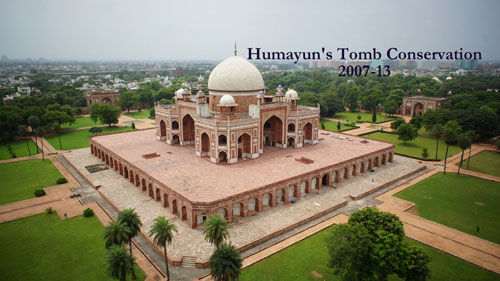|
|
The South
Asian Life & Times - SALT |
|
|||
|
Contents Feature Heritage People
Book Reviews Kaavad
Traditions of Rajasthan
- exploring
|
|
||||
|
Humayun's Tomb Complex The imposing mausoleum of the second Mughal Emperor,
Humayun, built in 1565 AD “established the paradigm for Mughal architecture
in the context of scale, style, setting and craftsmanship.” It was the first
garden-tomb, complete with causeways and channels, on the Indian
subcontinent - an architectural feat of the highest order. Designated a
UNESCO World Heritage Site in 1993, “the mausoleum and its peripheral
buildings were found to be in urgent need of conservation.” Humayun’s tomb was built by his widow, Biga Begum
(Hajji Begum), in 1569-70, fourteen years after his death. The architect was
Mirak Mirza Ghiyath. It was later used for the burial of various members of
the ruling family and contains many other graves. Built on a high terraced platform, in the centre of
a large garden, the sandstone and marble tomb took nine years to build. The
main entrance is on the south side, but it is the west entrance that is used
for visitors to the monument. The interior is a large octagonal chamber with
vaulted roof compartments interconnected by galleries. Humayun’s Tomb endured
centuries of neglect - water seeped through the roof, the blue Persian tiles
on the canopies were covered in dirt and grime, and the gardens were overrun
with a dense overgrowth of wild bushes. The use of cement on the building in
the early 20th century obliterated many artistic details.
Thousands of kilos of cement deposits were removed from the roof alone.
“In 1997, the Aga Khan Trust for Culture, a private
development agency, took on the Humayun’s Tomb project, and in 2007 it
partnered with Sir Dorabji Tata Trust, a philanthropic organization, and the
Archaeological Survey of India to commence the restoration work on the
structure.” It took 1,500 craftsmen six years to restore this magnificent
structure. Master craftsmen from Samarkand were brought to Delhi to train
local craftsmen in the art of tile-making. Conservation works are still being carried out on
the main mausoleum and other buildings within the complex such as the
gateways, pavilions and other tomb structures – Isa Khan’s tomb, Afsarwala
tomb, Barber’s tomb etc. The Batashewala Complex,
and Nila Gumbad, adjoining Humayun’s tomb, stand within the World Heritage
Site buffer zone.
The monuments within the Batashewala
Complex were built in the late 16th – early 17th century.
The
structures known as Bara Batashewala and Chota Batashewala Mahals were
actually tombs located within an, over 1000 m long, arcaded stone masonry
enclosure wall. Since I950s the Batashewala Complex had been inappropriately
used as a camp ground by Bharat Scouts. After decades of persistent requests
by conservation groups the ownership was transferred by the Government of
India to the Archaeological Survey of India in 2010, which made possible the
start of conservation works on the monuments. Nila Gumbad is the earliest Mughal period monument
in Delhi. Its unique tilework covers the façade of the structure.
|
|||||
|
Copyright © 2000 - 2015 [the-south-asian.com]. Intellectual Property. All rights reserved. |
|||||
